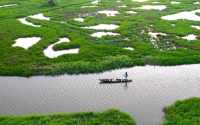10 January 2005planetark.com
PORT LOUIS - Small island nations meet in Mauritius from Jan. 10-14 for talks about threats including a creeping rise in sea levels blamed by most scientists on global warming.
The meeting is likely to be dominated by calls for early warning systems for natural disasters after Asia's Dec. 26 tsunami that killed more than 150,000 people. It will separately look at a feared slow rise of ocean levels in a warmer world.
Following are details of projected gains in sea levels:
ARE SEA LEVELS RISING?
A UN panel of more than 2,000 scientists predicted in its latest report in 2001 that average sea levels are likely to rise by 9-88 cms (3.5-35 inches) by 2100, mainly because of a build-up of heat-trapping gases in the atmosphere from human burning of fossil fuels.
"If the higher end of that scale is reached, the sea could overflow the heavily populated coastlines of such countries as Bangladesh, cause the disappearance of some nations entirely (such as the island state of the Maldives), foul freshwater supplies for billions of people and spur mass migrations," according to a UN statement.
The 2001 report said that seas rose by 10-20 cms in the 20th century, far faster than the century average for the past few thousand years.
Many scientists say that a 50 cm sea rise can typically cause a 50 metre retreat of the coastline where the land is relatively flat. Erosion can often happen in surges after cyclones, hurricanes or tsunamis.
A minority of scientists dismiss the UN findings about global warming and say they are based on erroneous climate models. Some others say they may underestimate risks from a melting of ice-caps in Antarctica and Greenland.
WHAT ISLANDS WOULD BE MOST AT RISK?
In the Pacific, island states barely above sea level include Kiribati, the Marshall Islands, Tonga and Tuvalu. In the Atlantic, Angigua and Nevis are vulnerable, as are the Maldives in the Indian Ocean.
WHAT EVIDENCE IS THERE?
The UN Environment Programme said on Thursday that Kiribati, the Marshall Islands and Tuvalu have already lost islets to sea level rise.
TUVALU - In February 2004, the nine islands of the Pacific atoll were submerged by "king tides", washing over much of the nation whose highest point is 4.5 metres over sea level. Once rare, king tides happen now once every two years and damage crops and freshwater sources, according to inhabitants.
NIUE - Cyclone Heta devastated the South Pacific island in January 2004, causing damage to houses and infrastructure estimated at eight times the island's gross domestic product.
Devastating storms have happened throughout history but the UN models predict that they will become more frequent in a warmer world.
HOW ABOUT ELSEWHERE?
About 17 million people live less than one metre above sea level in Bangladesh. Large areas of US states southern Florida or Louisiana would also be flooded if seas rose by a metre. Venice and London are among cities built in regions where the land is sinking, adding to the problems.
The United Nations projects that 80 percent of the world's population will live within 100 miles (60 km) of coastlines by 2010.
Huge cities just above sea level include Tokyo, Osaka, Bombay, Madras, Calcutta, Seoul, Bangkok, Dhaka, Karachi, Jakarta, Manila, Shanghai, Tianjin, Lagos, Cairo, Istanbul, London, New York, Los Angeles, Buenos Aires and Lima.






